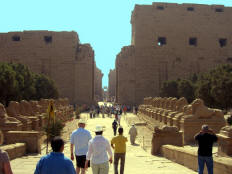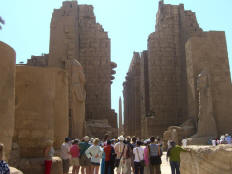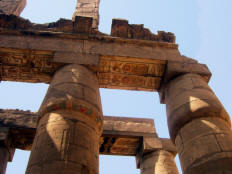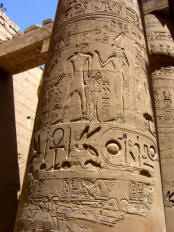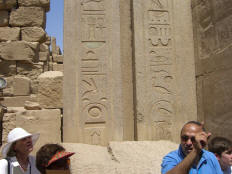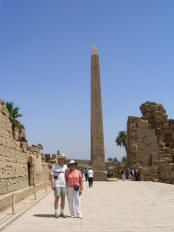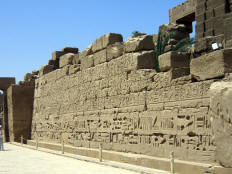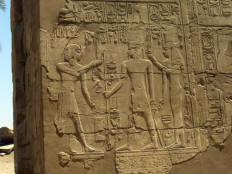Page 1 2 3 4 5 6 7 8 9 10 11 12 13 14 15 16 17 18 19 [History] Monday, 16 April. Today was hot! The below-average temperatures we'd been having were over. The buses left at 8:00 for the nearby Temple of Karnak. This was the world's largest temple complex, once covering almost 250 acres. Its construction extended for 1,300 years, engaging many generations of builders. It consisted of three main temples and several lesser ones. There are six successive pylons front to back, increasing in age from the entrance to the interior (since the later extensions were added in front of the previous entrance). Then, unlike other temples, there are four more pylons off the middle of the right side. Much of the temple is in ruins now, but what remains is still overwhelming. I mentioned before that a long processional way lined with sphinxes once ran between this temple and the Luxor Temple, and that was the first thing we saw on our arrival. (However, they were all ram-headed sphinxes here while those at the Luxor end had human heads.) We walked by the sphinxes, through the first pylon and into the first courtyard, bigger but not too different from the one at the Temple of Luxor. It had a row of ram-headed sphinxes, but they looked like they had been moved here from the processional way for storage, probably when the temple was expanded. Salah led us through the second pylon, and we found ourselves not in the usual relatively narrow colonnade, but in the Great Hypostyle Hall (hypostyle = a chamber where the ceiling is supported by columns). There was in fact a colonnade formed by six 70 foot columns on each side, but in neat rows behind these were 122 additional 50 foot columns in a huge (330'x 170') rectangular hall. It was like a forest of columns, and all were elaborately decorated. As we continued through the remaining pylons toward the sanctuary, less and less of the original temple remained intact. The sanctuary itself was gone, but two large obelisks remained in one of the inner courtyards. We had been with Salah for more than an hour as he led us through the main temple and explained its various features. Then he turned us loose to explore on our own until 11:30, directing us toward the pylons off to the side, where he hadn't taken us. He also called our attention to the Sacred Lake in the same direction. Our total time at Karnak was more than three full hours, the most we'd had at any temple, and we really enjoyed it. I must have taken a hundred pictures. (Many of them were duplicates because the temple was so large that I inadvertently photographed the same things on the way out that I had photographed hours before on the way in.)
Page 1 2 3 4 5 6 7 8 9 10 11 12 13 14 15 16 17 18 19 [History]
Copyright © 2000-2023 DarrellPeck.com All rights
reserved. | |||



